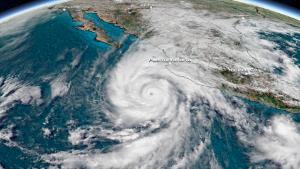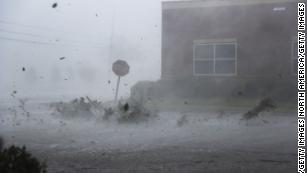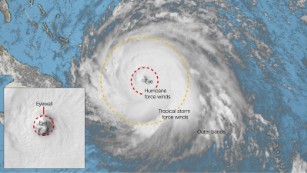Willa's maximum sustained winds dipped slightly to 155 mph Monday evening. On Monday morning, they were 160 mph, making Willa a top-of-the-scale hurricane. Its current intensity is about the same as Hurricane Michael's when it made landfall in Florida's Panhandle less than two weeks ago.
The storm has supercharged at an incredible rate since it formed over the weekend. From Sunday morning to Monday morning, Hurricane Willa strengthened 80 mph in 24 hours, and went from forming into a tropical storm on Saturday morning to a Category 5 in less than 48 hours.
The official forecast from the National Hurricane Center calls for Willa to weaken some before landfall on Tuesday, but the storm is still expected to be a dangerous major hurricane.
Willa is located about 135 miles south-southwest of Islas Marias, an archipelago off central Mexico's Pacific coast. The hurricane is moving north at 8 mph and is forecast to move "over or very near" the Islas Marias early Tuesday, according to the National Hurricane Center. Landfall on mainland Mexico is expected Tuesday afternoon or evening.
The hurricane is on track to be one of the strongest hurricanes to ever hit the Pacific coast of Mexico and its landfall will come three years to the day after the strongest, Hurricane Patricia, made landfall one state to the south, in Jalisco.
Hurricane Patricia
went from a Category 5 to Category 4 when it made landfall, but at its peak, Patricia had winds of 215 mph and was the strongest hurricane or typhoon ever observed anywhere on the planet.
In addition to Willa, Mexico is bracing for another tropical system right behind it, Tropical Storm Vicente. While Vicente is considerably weaker than Willa, it is expected to make landfall late on Tuesday night or Wednesday morning about 250 miles south of Willa and will give the western coastline of Mexico a rapid 1-2 punch from Mother Nature.
The back-to-back systems have helped make the 2018 hurricane season in the northeast Pacific one for the record books.
The season is now the most active hurricane season on record using a measurement called "Accumulated Cyclone Energy," which combines the number of storms and their intensity through their lifetimes to give an overall measurement of tropical activity in a given region.
2018 has seen 10 major hurricanes, including Willa, which ties 1992 as the most major hurricanes seen in the northeast Pacific in one year.
Increasing numbers of major hurricanes, along with a greater propensity of storms to undergo "rapid intensification" are expected consequences of
warmer ocean waters resulting from climate change. The ocean waters off the western coast of Mexico are running 1-2 degrees Fahrenheit above average for late October.


























No comments:
Post a Comment